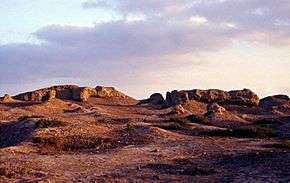Buto
| Βουτώ | |
 View of Buto | |
 Shown within Egypt | |
| Alternative name |
Butus Tell El Fara'in |
|---|---|
| Location | Kafr El Sheikh, Egypt |
| Region | Lower Egypt |
| Coordinates | 31°11′47″N 30°44′41″E / 31.19639°N 30.74472°ECoordinates: 31°11′47″N 30°44′41″E / 31.19639°N 30.74472°E |
| Type | Settlement |
| Site notes | |
| Condition | In ruins |
Buto (Greek: Βουτώ, Arabic: بوتو, Butu),[1] Butus (Greek: Βοῦτος, Boutos),[2] or Butosus, now Tell El Fara'in ("Hill of the Pharaohs"), near the villages of Ibtu (or Abtu) and Kom Butu and the city of Desouk (Arabic: دسوق),[3] was an ancient city located 95 km east of Alexandria in the Nile Delta of Egypt. In Classical times, the city stood about midway between the Taly (Bolbitine) and Thermuthiac (Sebennytic) branches of the Nile, a few kilometers north of the east-west Butic River, and on the southern shore of the Butic Lake (Greek: Βουτικὴ λίμνη, Boutikē limnē).[4]
Buto originally was two cities, Pe and Dep,[5] which merged into one city that the Egyptians named Per-Wadjet.[6] The goddess Wadjet was its local deity, often represented as a cobra, also considered the patron deity of Lower Egypt. Her oracle was located in her renowned temple in that city. An annual festival held in the city celebrated Wadjet. The city also contained a sanctuary of Horus and much later, became associated with Isis.
The city was an important site in prehistoric Egypt that includes the cultural developments of ten thousand years from the Paleolithic to 3100 BC. Archaeological evidence shows that Upper Egyptian culture replaced the Buto-culture at the delta when Upper and Lower Egypt were unified, and the replacement is considered important evidence for the unification of the two portions of Egypt into one entity. At that time Wadjet joined Nekhbet, who was represented as a white vulture and held the same position as the patron of Upper Egypt, and together they were known as the two ladies [4] who were the patrons of the unified Egypt. The image of Nekhbet joined Wadjet on the Uraeus that would encircle the crown of the pharaohs who ruled the unified Egypt.
The Greeks coined the toponym Buto under the Ptolemaic Kingdom a dynasty that ruled from 305 to 30 BC. It served as the capital, or according to Herodian, merely the principal village of the Nile Delta. Herodotus (l. c.) styled it the Chemmite nome, Ptolemy knew it as the Phthenothite nome (Φθενότης, iv. 5. § 48), and Pliny the Elder as Ptenetha.[7]
The Greek historians record that the town was celebrated for its monolithite temple and oracle of the goddess Wadjet (Buto),[8][9] whom the Greeks identified with Leto or Latona. A yearly feast was held there in honour of the goddess.
They noted that at Buto there was also a sanctuary of Horus (associated by the ancient Greeks with Apollo) and of Bastet (associated with Artemis).[10]
The Greek name, Buto, is nearly allied to that of Muth or Maut, their appellations for Isis, as Mother of the World.[11]
According to these same late sources, the shrew was worshipped at Buto.[12]
See also
- Diocese of Buto for ecclesiastical history and current titular sees
- Desouk
- Kafr El Sheikh Governorate
- Sais, Egypt
References
- ↑ Steph. B.
- ↑ Herod. ii. 59, 63, 155.
- ↑ Wilkinson, R. H. The Complete Temples of Ancient Egypt, Thames & Hudson 2000, p. 104.
- ↑ Strabo xvii. p. 802. John A. Wilson, Buto and Hierakonpolis in the Geography of Egypt, Journal of Near Eastern Studies, Vol. 14, No. 4 (Oct., 1955), pp. 209-236, The University of Chicago Press, Chicago (1955).)
- ↑ Strabo, XVII., i., 18
- ↑ Webpage for Buto, modern Tell El Fara'in at the website of the DAI.
- ↑ v. 9. s. 11
- ↑ Herod. ii. 155
- ↑ Aelian. V. Hist. ii. 41
- ↑ Champollion, l'Egypte, vol. ii. p. 227.
- ↑ Plut. Is. et Osir. 18, 38.
- ↑ Herod. ii. 67.
Sources and external links

| Wikimedia Commons has media related to Buto. |